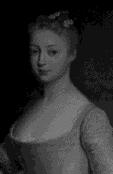Last Updated: 18 Nov 2005
CHILD 12.

 Baron [Count] Frederick von der Trenck
of Koenigsberg, E. Prussia, son of Major-General
von der Trenck, Lord of Scharlac, Schakulack, & Meiken and Marie Charlotte,
nee Derschau [Dirschau, Dessau, Tczew] ,who was later known
as Countess Lostange.... , dau. of Albrecht von Derschau,
See more information
Baron [Count] Frederick von der Trenck
of Koenigsberg, E. Prussia, son of Major-General
von der Trenck, Lord of Scharlac, Schakulack, & Meiken and Marie Charlotte,
nee Derschau [Dirschau, Dessau, Tczew] ,who was later known
as Countess Lostange.... , dau. of Albrecht von Derschau,
See more information
Children [twins]:
1743
When Frederick II "the Great" discovered his sister Amalia had secretly married and was pregnant, he flew into a rage and sent her off to the Abby of Quedlinburg [a place where aristocratic families' often sent their daughters who gave birth to children out of wedlock]. Her marriage was annulled.
Other Interesting Historical Notes About Amelia
Abbes of Quedlinburg
1753
About ten years later Amalia, who never married, again, became the Abbes of Quedlinburg when the Abbes Maria Elisabeth died in 1756 and was so until she died in 1787.. This made her a wealthy woman. The Abby often recieved generous figts such las land (150 estates), precious books, manuscripts, such as the Saxonicae Annales Quedlinburgenses written from 1008 to 1030, etc. etc... All Abbesses up to 1806 were princess of the Holy Roman Empire and given a seat in the College of Princes and a vote at the Diets. It was considered a "free secular Imperial Abbey of Quedlinburg. Therefore considered property of the Imperial Family. Although wikipedia tells us that they were under the Pope of Rome, Anna Amelia was not, as she was Lutheran. And the Abby had been Protestant since Abbess Anna II (Countess Stolberg) since the Reformation.
The Abby of Quedlinburg was in 1753 in the German state of Saxony-Anhalt .
Near by was the institution for the education of daughters of the nobility founded in 919 by Queen Mathilde
The town of Quedlinburg lies along the River n the northern Harz Mountains.
Amelia continued to have communication with Trenck , make sure he had money to buy necessary items while in prison. She finally gained Trenck's release with the permission of her brother, Frederich II "the Great".
Music
Handel's Messiah
Discovered on a pamphlet handed out at the San Francisco Symphony's Handel's Messiah [p. 18B]was, and I quote: "What did Moazart do and how did he come to do it? The instigator was Baron Gottfried von Swieten, whose Dutch father had been personal physician to the Empress Maria Theresa.....While posted in Prussia, van Swieten became acquainted with Princess Anna Amalia, sister of Frederick the Great, and the circle of musicians around her which was headed by Johann Sebastian Bach's learned pupil, Johann Philipp Kirnberg. Through these musicians--the Princess herself was a very good one--he came to know the music of Sebastian and Carl Philipp Emmanuel Bach. He had already become a Handelian."
"In the 1870s van Swiertyern organized a group of wealthy patrons who called themsevles the Associierte. It was for their concerts that Mozart rescored Messiah...."
Literature
During the years 1751 to 1753 Voltaire was at the court of Frederick the Great of Prussia Potsdam. There he met Amelia and learned about her lover Trenck for whom he later wrote Candide.
Candide was more than a satire of Leibniz's view of philosophical optimism it was a satire on Trenck's life and the injustices from Frederick "The Great" with whom Voltaire had just fallen out of favor [1753].
Devin M. Hubert, descendent of Trenck, wrote his final paper at UC [Berkeley] on Candide because he recognized in the first line "IN the castle of Baron Thunder-ten-tronchk ..." Voltaire was refering to Baron Frederik von der Trenck's family and Frederick's adventures.
More Photographs of Princess Amalia of Prussia
| Photograph #2 |

|
||
| Photograph #3 |
 Photo from family's
private collection. Photo from family's
private collection.
|
||
| Photograph #4 |

|
||
| photograph #5 |

|
||
| LINKS | http://en.wikipedia.org/wiki/Princess_Anna_Amalia_of_Prussia |
History of Quedlinburg Abbey
Th abby was founded by the widow of Henry "the Fowler" (der Vogler) in 936. There existed on the hill an old castle which became the Abby with improvements, of course. From 936 to 1500 it was Catholic and under the Pope in Rome which was protected by the Emperors of the Holy Roman Empire. After the Reformation the Abby became Protestant. In 1539 the town and abbey turned to Lutheranism. In 1697 Frederick Augustus I, Elector of Saxony sold the rights for 240,000 thalers the Quedlinburg Abbey to Elector Frederick III (House of Brandenburg) and it's ownership continued under the House of Hohenzollern, the minor house of Brandenburg.
In 1803 it became Secularised to Prussia.
In 1816 it was taken into the Province of Saxony.
A side note. The abbesses of Quedlinburg were without "taking the veil" and were free to marry.
List of Luheran women's convents were:
Changes to Lutheran:
